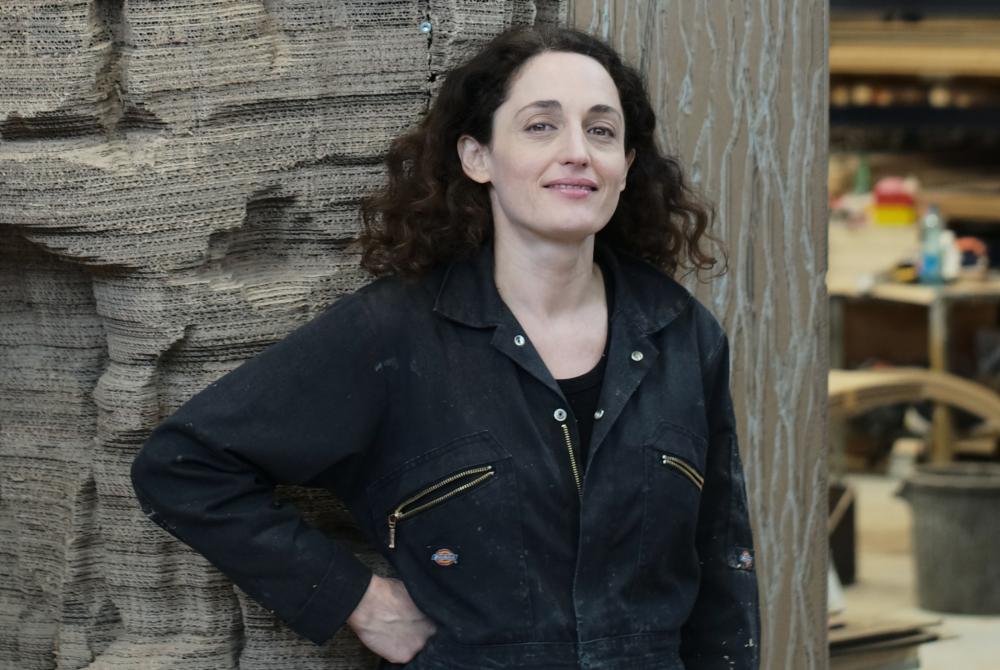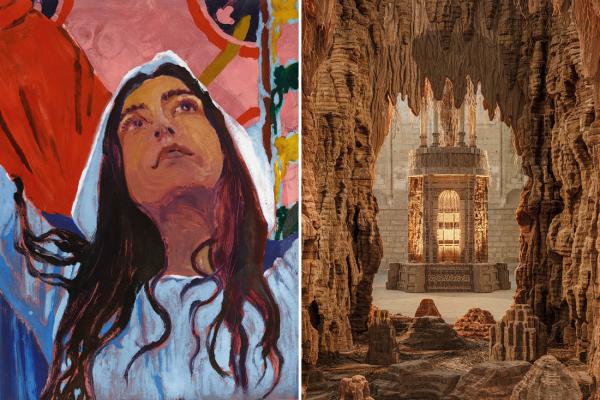Votre panier est vide
Besoin d'inspiration ?
Rendez-vous dans le programme en ligne du GrandPalais
Article -

The term was forged in the 19th century and was employed for the first time by Norman archaeologist Charles Duhérissier de Gerville.
This art is expressed through the monumental character of its architecture, as well as through rich sculpture and particularly delicate painting. Romanesque art borrows from a variety of sources: Carolingian, Antique as well as Byzantine, Middle Eastern and Celtic.
The fact that people, and objects, travelled more widely encouraged a revival in visions and images. The Romanesque period saw the emergence of politico-religious phenomena (crusades, pilgrimages to Santiago de Compostela) which created a link between the largest cities. It is also characterized by the worship of relics. In France, Romanesque art also flourished from the second half of the 11th century and emanated in particular from the Abbey of Cluny.
Architecture
Numerous buildings, especially many abbeys and monasteries, illustrate the development of Romanesque architecture, almost exclusively religious. This style is above all characterized by rigour as well as relative austerity: in a society which was entirely focussed on the divine, art was used to promote contemplation, prayer and meditation. Everywhere, spaces were designed around the liturgy. The role of light was central to this: greater to the East, where the Eucharist was celebrated, light beautifully illuminated the altar, functioning like a sacred emanation.
Romanesque art appeared in northern Italy in around AD 1000, with churches in the form of an upturned ship. This image led to the main body of the buildings being called the “nave” (Medieval Latin navis, “ship”). Little by little, from the end of the 11th century, new churches and monasteries everywhere were built in this style.
Romanesque art also followed the development of mendicant orders (Carmel, Dominican and Franciscan). Artists, commissioned by the great builder abbots such as those of Cluny (Benedictine order), as well as bishops and kings, borrowed Roman walls, triangular pediments and columns supporting entablatures from Antiquity and the construction of domes from Byzantium.
The numerous fires which ravaged the oldest buildings provided an opportunity for reconstruction which put into practice progress made in terms of dressed stone construction. These buildings are all covered in vaulted ceilings, the scale and height of which are dictated by the timber frame, a system inherited from Antique basilicas. It was precisely to avoid timber fires that various stone vaults (groined vaults, ribbed vaults, barrel vaults, domes) were created with their abutments. The wall surface tends to include wider and more numerous bay openings, to allow light into the church and reduce the monolithic aspect of the façades.
Whether in relation to large churches, monastic cathedrals or sanctuaries, the layouts were very varied. While the positioned basilica layout (Latin cross facing east) was the most common, there were many variations of it. The Greek cross layout was common in Italy, while the Germanic Holy Roman Empire, in the Rhine religions, preferred hall churches with a single, often astonishingly decorated, nave in which ivory and bronze treasures echoed the richness of the carved decoration.
Sculpture
Romanesque sculpture blossomed through iconography which blended the mystical and fantastic, education and imagination. The appearance of strange animals (dragons, griffons) which invaded it was inspired by the Middle East and European folklore. Very closely linked to architecture, sculpture developed essentially on the building’s structural elements. Whether decorating capitals in the crypt, or embellishing cloisters and churches, Romanesque sculpture fostered a horror of emptiness, or to put it another way, the suitability of the scenes presented depended on the constraints of their medium, also called the law of the frame. It also encouraged transmission of knowledge as a result of the symbolism of the subjects or the parallels between the Old and New Testaments.
At the end of the 11th century, carved decoration appeared on the façades of churches, resembling ancient triumphal arches, and symbolically marking the passage from the profane world to the sacred realm. A masterpiece of Romanesque art, the Saint-Sernin basilica in Toulouse (registered on Unesco's world heritage list) retains a remarkable series of figural capitals.
The most important bases of Romanesque art spread out from Cluny (Burgundy, Auvergne, all the way to Compostela in Spain) or from Provence (Arles, Saint-Gilles-du-Gard). In Italy, Romanesque artists drew lessons from Antiquity with they were very familiar with due to the proximity of ancient sites and the possibility of admiring excavated artefacts. They developed their own figurative style, in both sculpture and painting. Gradually breaking away from Byzantine models and their hieratic canons, they drew inspiration directly from Antiquity, thereby creating the foundations of an artistic renaissance.
Ornamental painting: between Classicism and imagination
The success of Romanesque painting is demonstrated by the many surviving relics. Frescoes from crypts in the church of Saint-Germain in Auxerre, inspired by Paleochristian art, are a remarkable testament to this. The arts of fresco, stained glass and precious media are also particularly rich. Craftsmen draw inspiration from Antiquity and the Carolingian renaissance, as well as the Middle East and Barbarian traditions. Illumination was a fertile area for this new creativity. Whatever the technique adopted, a sense of realism and naturalism can be felt, particularly in the attention paid to detail. The subjects, often inspired from manuscripts (such as Moralia in Job at Citeaux abbey, executed in 1100), are sometimes decorated with mundane references, sometimes fabulous. At the same time, the major sacred iconographic themes such as the Last Judgement, the Pentecost and the Apocalypse, were represented on the façades of Romanesque buildings.
The walls were not only decorated with frescoes, but also tapestries. One of the most famous in Romanesque art is the Bayeux tapestry (classified as "World memory" by Unesco), an 80m long embroidery produced in the 11th century, recounting the conquest of England by William the Conqueror in 1066. It was housed in Bayeux cathedral. Today it can be admired in the Tapestry Museum in the same town.
In Italy, and in the German Holy Roman Empire, Romanesque painting, like sculpture before it, was characterized by a certain Classicism. This measured style can be found again in the famous paintings from the Floreffe Bible (London, British Library) and the Evangelia of Averbode (Liège, university library). It developed particularly in northern Italy, notably over the course of the various stages of bronze gates of Saint Zeno in Verona. At the same time, the style at Citeaux abbey reflected more spontaneity and exuberance.
The flourishing of precious arts
In around 1100, southern France was marked by an increase in enamelling. The alabaster altar of the treasure of Conques is one of the most famous examples. It has a wide gilded copper border with medallions set into it, decorated with a whole range of fantastic bestiary.
These enamels, which are serve both a decorative and narrative purpose, then experienced extraordinary success due to their brilliance and colours. The plaques (executed circa 1189-1190) from the Gramont altar, near Limoges, are among the greatest masterpieces in enamelling.
Romanesque art dominated in the West for almost two centuries. Its exceptional creative richness still fascinates and astonishes to this day.
Votre panier est vide
Besoin d'inspiration ?
Rendez-vous dans le programme en ligne du GrandPalais
See content : In the fantastic world of Eva Jospin: 8 questions for the artist

Article -
At the Grand Palais, Eva Jospin's "Grottesco" exhibition offers a timeless journey. Mysterious caves, sculpted nymphaea, petrified forests and "embroidered tableaux" come together to form a world apart. In this interview, the artist reveals her sources of inspiration, her relationship with cardboard and embroidery, and the way she turns each viewer into an explorer of her fantastical landscapes.
See content : Mickalene Thomas at the Grand Palais: an ode to love and black beauty!

Mickalene Thomas, Afro Goddess Looking Forward, 2015
Article -
It’s happening today! The exhibition All About Love opens its doors. With flamboyant portraits, self-assured bodies and bold expressions of femininity, Mickalene Thomas celebrates the beauty of Black women at the Grand Palais. A joyful and committed...
See content : It's open! Eva Jospin and Claire Tabouret: two new exhibitions at the Grand Palais

Article -
Until March 15, you're invited to explore the fascinating worlds of Eva Jospin and Claire Tabouret, presented in two Grand Palais galleries linked by the same entrance.